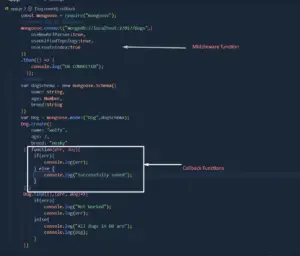In this tutorial, we are gonna learn about the use of middleware functions, their types, and how they are used. Along with this, we will see the working of a callback function and what is known as callback hell.
What are Middlewares in Node?
Middlewares are the functions that act as a barrier stage between the user/client request and the response on the server. It takes the basic three parameters in the functions they are request, response, and next respectively.
Request handles the user/client request like getting a post or delete.
Response sends the allocated response when all the in-between conditions of middleware are cleared.
Next function triggers the next function whether it is another middleware or callback or response.
Need of Middlewares
- Middleware functions are developed for the process to be carried out by the application in between request and response process of server and client.
- Multiple middlewares are used in a single request call this is called a middleware chain.
- The middleware functions are used to verify the conditions or accessing purpose or to even load a static file for the web application.
Types of Middleware
- Application-level middleware
- Ex:- Auth middleware etc
- Router-level middleware
- EX:- router.use
- Built-in middleware
- EX:- express.static
- Error handling middleware
- Third-party middleware
CallBack in Node App
⇒The callback is a function that is called when a given task is completed. The node js use callback functions very vastly.
⇒Every request made and process through that request are carried out by the user client are finished by a callback function.
⇒ The callback can be nested within the functions and that is known as callback hell.
Code explaining callback and middleware.
Note:- This code is from the previous tutorial explaining the use of middleware and callback.
